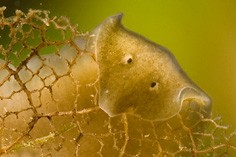Flatworms
Feeding:
Primary predators feeding on various soft-bodied invertebrates. They also scavenge on carrions of larger animals and consume significant portion of algae and detritus.
Habitat:
Flatworms mostly inhabit shallow regions of both still and running waters. They often occur on a solid surface of stones and submerged wood.
Movement:
Clingers gliding on a thin layer of secreted mucous. The movement is accomplished by cooperation of microscopic hairs (cilia) and muscular contractions.
Size:
Dugesiid flatworms grow up to sizes around 15 mm.
Life cycle:
Flatworms are mostly hermaphrodites reproducing both sexually and asexually. Eggs are attached to the substrate singly, grouped, or placed in cocoons. Emerged flatworms develop directly (without intermediate larval stage) and grow until they are capable of reproduction.
Other characteristics:
Species within the genus Dugesia can be recognized by arrow-shaped head and distinct eyes. Position of the simple eyespots makes the flatworms appear cross-eyed. However, these primitive eyes can just detect light intensity and cannot form images. There is only one opening into the digestive tract, which is located at the bottom side (in approximately half the length of the body). The “mouth” is located on the extendible tube (pharynx) that can be pushed out of the body to suck fluids, organic particles or whole small organisms. Food is digested in a highly branched intestine.
unsegmented body is soft and flattened; oxygen is absorbed through the overall body surface; incomplete gut with only one opening; they lack the major body cavity (coelom); flatworms are known for their remarkable regenerative ability
Flatworm (Dugesia gonocephala):















